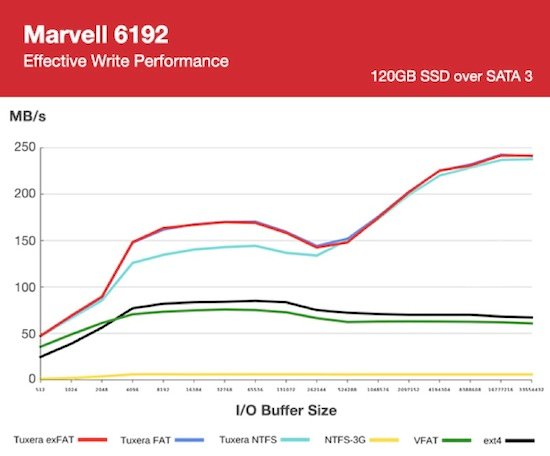Tuxera has introduced FAT+, a new file system for removable storage on embedded systems that’s compatible with FAT32 but without the limitations such as the 4GB file size limit, and brings fail-safety and performance optimization. FAT+ is allegedly one of the recommended file systems by the Universal Flash Storage Association (UFSA) for the next-generation Universal Flash Storage (UFS) cards. Some of the key features of Tuxera FAT+ implementation include: Supported Operating Systems – Android, Linux, Chrome OS, Firefox OS, Tizen Hardware Architecture – ARM, ARM64, Intel x86/x86_64 or compatible, MIPS, MIPS64, PowerPC, SH4, and more Capacity Maximum volume size – 2 TiB with 512-byte sectors, 16 TiB with 4096-byte sectors Maximum allocation block size – sector size in bytes x 128 Maximum file size – 16 TiB Maximum filename length – 255 characters (16-bit) Supported sector sizes – 512, 1024, 2048, and 4096 bytes Interoperability Conforms to all Microsoft FAT […]
Tuxera FAT Embedded Boasts Faster and Better FAT32 Implementation for Embedded Linux and Android
Tuxera has announced their “FAT Embedded” implementation of the FAT file system specifically optimized for embedded Linux and Android. The company claims their commercial solution delivers much faster data transfers than competing FAT implementations. Beside providing better performance, it also includes features such as fail-safe operation, and lower power consumption. They’ve benchmarked different file systems including Tuxera FAT Embedded with different I/O buffer sizes on two embedded hardware: Marvell 6192 @ 800 MHz with 512 MB RAM and a 120 GB Corsair Force GT SSD (SATA 3) The write speed of Tuxera exFAT and FAT appears to clearly outperform even ext-4 in this particular system. As a side note, I also evaluated 2 embedded systems based on the same low-end CPU: one using NTFS-3G, and the other Tuxera NTFS back in 2010, and there’s was a massive performance difference at the time. NTFS-3G is a different beast as it uses […]




